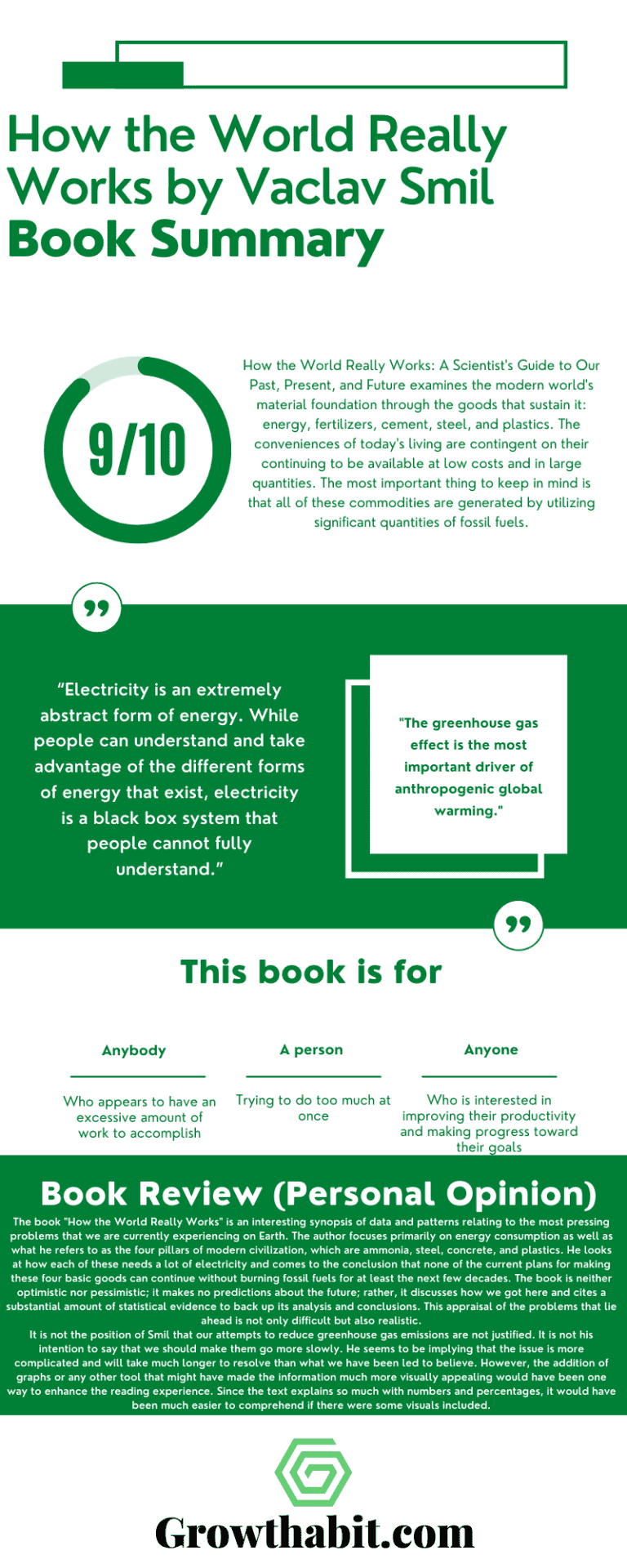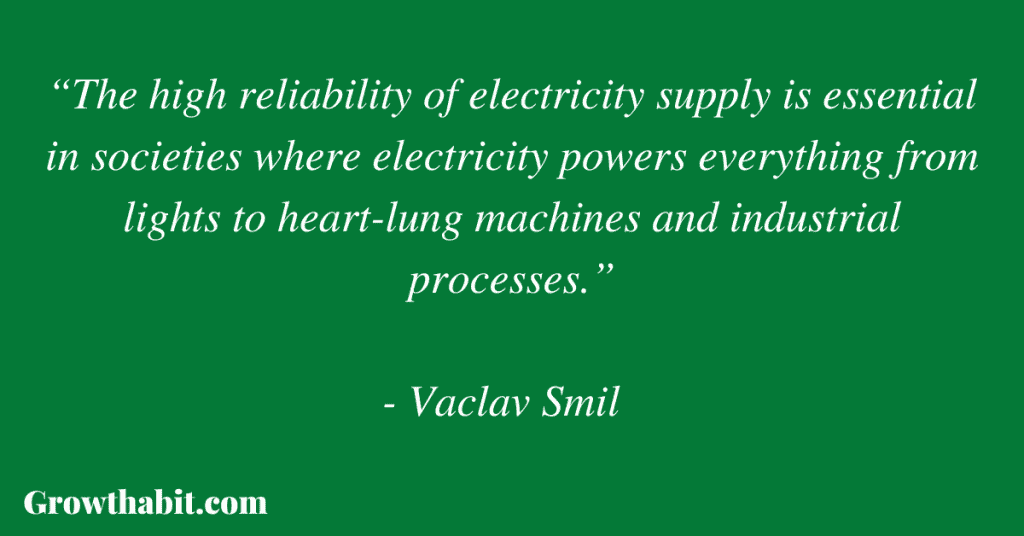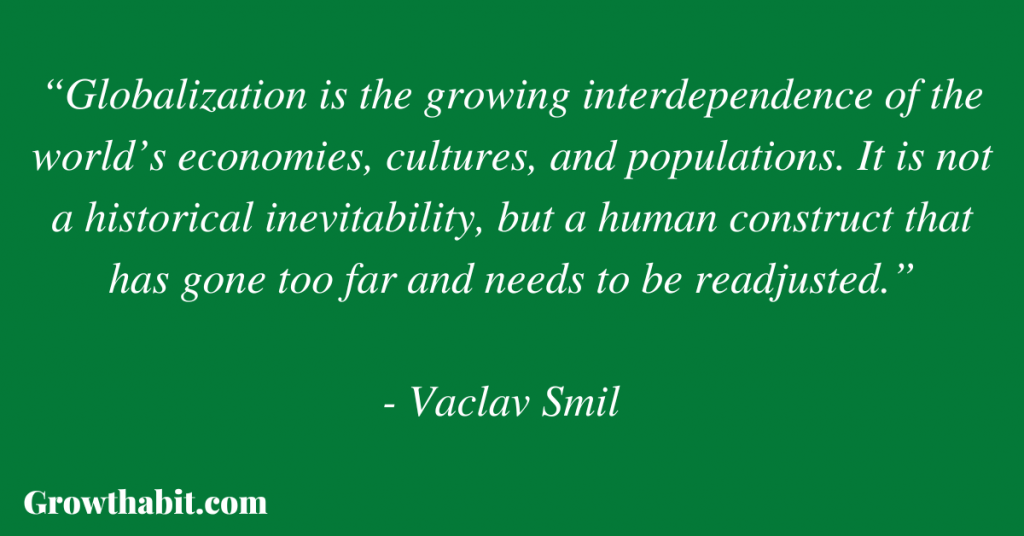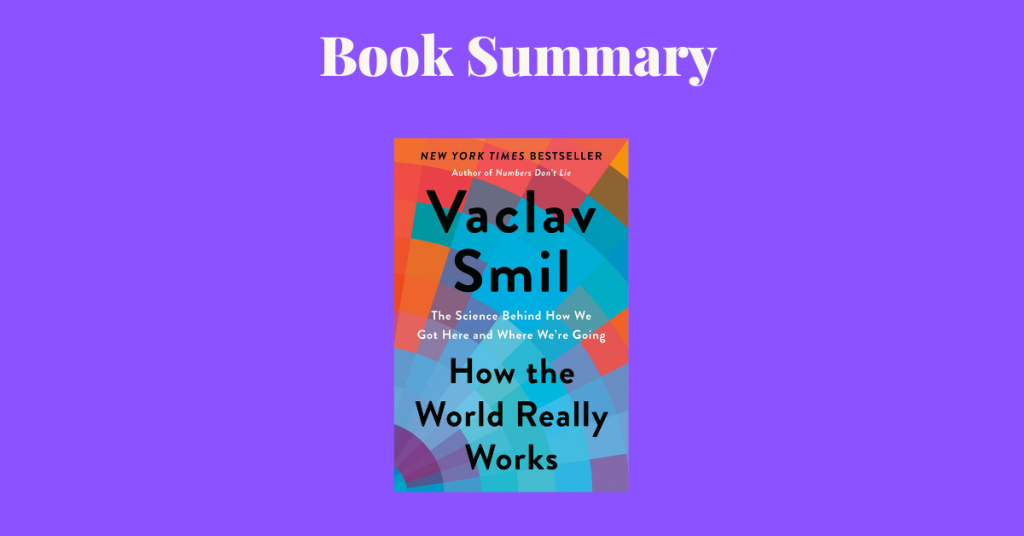How the World Really Works: A Scientist’s Guide to Our Past, Present, and Future examines the modern world’s material foundation through the goods that sustain it: energy, fertilizers, cement, steel, and plastics.
The conveniences of today’s living are contingent on their continuing to be available at low costs and in large quantities. The most important thing to keep in mind is that all of these commodities are generated by utilizing significant quantities of fossil fuels.
The author offers a revealing and comprehensive survey of the factors that contribute to human health and prosperity.
How they might be retained despite worrisome indicators of ecological collapse, as well as which specific disturbances to them, such as those presented by viral pandemics or climate change, are truly the most dangerous.
Book Title— How the World Really Works: A Scientist’s Guide to Our Past, Present, and Future
Author— Vaclav Smil
Date of Reading— August 2022
Rating— 9/10

What Is Being Said In Detail
Understanding Energy
Chapter 1, it is talked about how energy works and its impact on the world. Since the early days of human existence, we have learned to take advantage of the various stages of our evolution of the energy that the world provided.
One of the greatest discoveries was energy through fossil fuels. By 2020, more than half of the world’s electricity will still be generated by fossil fuels, mainly coal and natural gas. The shift from coal to crude oil took generations to accomplish.
Commercial crude oil extraction began during the 1850s in Russia, Canada, and the US. New markets for refined oil products were created with the adoption of internal combustion engines.
The discoveries of giant oil fields in the Middle East and in the USSR made oil a global fuel. The result of the burning coil has had a bad impact on the environment. But as the years pass, new ways of obtaining energy have appeared.
These new technologies are seen as renewable, but the author argues that maybe this renewable energy could not be enough to replace today’s generation fueled by coal and natural gas.
On the other hand, it is assured that electricity has many advantages that humans have not focused entirely on. But, unfortunately, it is still not possible to store electricity affordably.
Energy, although much more used these days, represents only 18% of the global energy consumption. Although decarbonization, which is the term applied to reducing the use of fossil fuels, is on the rise, it still has a long way to go.
Understanding Food Production
In Chapter 2, Vaclav Smil explains that food production is dependent on two different kinds of energy: natural (sun) and artificial (fossil-fuel-based).
This energy has not changed throughout the years, but the quantity of food produced with certainty has changed and the rapidity of the production has increased immensely.
What 200 years ago took 10 minutes to produce, in recent years can take only 2 seconds. This improvement is derived from the machinery used nowadays.
But we must remember that machines consume fossil fuels. And to promote the optimal growth of crops, agrochemicals are a must. In this chapter, not only are crops examined, but also animal meat and the energy required for us to consume it.
Here are some examples: a roasted chicken costs 300-350 ml of crude oil, 210-250 mL/kg for bread, and two skewers of medium-sized wild shrimp require 0.5-1 liters of diesel.
Food production has a lot of phases to arrive at our table: marketing, packaging, transportation, wholesale, retail service, household food storage, and preparation.
And, while some wealthy countries pursued mass-scale veganism in an effort to decarbonize, others, such as Brazil, increased meat consumption.
The author states that there are opportunities for decarbonization by decreasing the use of fossil fuels and instead using renewable energy.

Understanding Our Material World
In Chapter 3, there are explained the four materials that are indispensable for the functioning of modern societies: cement, steel, plastics, and ammonia.
Global production of these four materials claims 17% of the world’s primary energy supply and 25% of all CO2 emissions. Ammonia is a substance that contains nitrogen and it is used in food production to increase production. Nowadays, we are highly dependent on ammonia.
The author stated that we could reduce our dependence on ammonia by cutting our food waste and using fertilizers more efficiently. Plastics are greatly used world-wide but in recent years have represented a great problem because of the great waste they represent.
Steel determines the look of modern civilization and enables its most fundamental functions. Since transportation, housing, industries, entertainment, manufactories, etc.
The oil and gas industry also depends on steel buried close to the surface in gathering, transmission, and distribution pipelines, which also emits a lot of CO2 into the atmosphere.
Finally, concrete is as important as steel, being a crucial part of today’s infrastructure. The author concludes this chapter by stating that these industries are unlikely to stop contributing to world CO2 emissions by 2050.
This is especially unlikely in countries with low incomes that are trying to catch up with the rest of the world. Their infrastructure and consumer needs require large-scale material growth.
Understanding Globalization
In Chapter 4, Smil explains how, thanks to globalization, we can access and have all the commodities and technology in our surroundings. Although it is not new, it has increased considerably in recent years.
Through the years, airplanes and radio enabled long-distance travel. Diesel engines brought efficiency and performance to commercial ships. Between 1950 and 1973, the world experienced a spell of rapid economic globalization.
This was enabled by advances in diesel engines, supercomputers, container ships, and jetliners. The first half of the 20th century saw a significant retreat from economic globalization.
The decades were marked by an unprecedented concatenation of large-scale tragedies and reversals of national fortunes.
This means that the high degree of globalization reached during the first two decades of the 21st century has not been inevitable. In other words, self-sufficiency is now impossible for any country.
Understanding Risks
In Chapter 5, the author demonstrates some of the advances of modern civilization to reduce the risks that come from us being complex organisms trying to survive against many odds.
Given the complexity of our bodies and the unpredictability of natural processes, it is not surprising that risks continue to abound in the modern world. The world is full of constant or episodic risks, but also replete with wrong perceptions and irrational risk appraisals.
He lays out themes such as diet and its impact on our lives. And while we could search for a very healthy diet, there are many other variables that dictate our survival.
Smil explains that the finality of dying provides a universal, ultimate, and incontestably quantifiable numerator that can be used for comparative risk assessment.
He goes on to say that we’d have to wipe out whole regions of Earth to significantly cut the odds of any and all local or regional natural disasters.
From massive earthquake-triggered tsunamis to mega-volcanic eruptions, there are many large-scale disasters that humans can either prepare for or do nothing to stop.
Understanding the Environment
In Chapter 6, Smil explains why he opposes leaving Earth for Mars. Mars’ polar caps, minerals, and soil would only yield 7% of the CO2 needed for long-term habitation.
To live, we must ensure that our interventions don’t threaten the planet’s habitability. There are nine things on the list that threaten these important biospheric limits. Climate change, ocean acidification, changes in land use, and chemical pollution are just some of them.
As we have seen in previous chapters, food production has had the greatest impact on Earth’s ecosystems. Better farming practices, less food waste, and moderate meat intake could minimize food production land, and, of course, much better agronomic management is essential.
Smil also addresses the concern about the greenhouse phenomenon. The natural warming of the Earth is controlled by trace gases whose concentration is unaffected by ambient temperature. Thousands of years ago, humans began changing trace gas concentrations.
Combustion of fossil fuels and cement manufacture have driven up CO2 emissions. Continued greenhouse gas emissions will raise temperatures sufficiently to harm the environment.
And the author remarks that although climate change has been a widely discussed topic since the 1980s, not much has been done to pursue decarbonization. He sadly affirms that “there should be no unavoidable apocalypse by 2030 or 2050.”
Understanding the Future
In Chapter 7, the author exposes the flawed ideas behind so-called “catastrophism,” which is the belief that human life is doomed to end in the near future, and “techno-optimism,” which is a similar belief that engineers can solve all of our existential problems with utopian solutions.
He describes three forecast types. First, those with well-known mechanisms and limited results. Second, those that point in the right direction but are ambiguous.
Lastly, there are the ones that come from complicated interactive models with a lot of variables but no real-world processes.
He explains that there are many scenarios, but certainly, the future is difficult to predict. And although humanity has changed a lot throughout the years, our basic needs have not. The need for food and water is very much still present.
Vaclav Smil closes his book by saying he’s a scientist, not a pessimist or an optimist. Understanding our past, present, and unknown future is the best basis for what’s to come.
The future would most likely be a mix of progress and setbacks, overwhelming obstacles and unexpected advances. ” The future is not predetermined but depends on our actions.”
Most Important Keywords, Sentences, Quotes
CHAPTER ONE – Understanding Energy
“The most important factor in the rise of civilization is the increasing dependence on fossil fuels.
The amount of energy available to humans has tripled since the 19th century, and an average Earthling has at their disposal about 700 times more useful energy than their ancestors had at the beginning of the 19th century.”
“Energy is among the most elusive and misunderstood concepts. It exists in various forms, and to make it useful to us, we must convert one form of it into another. But treating this multifaceted abstract as a monolith has been the norm, as if different forms of energy were effortlessly substitutable.”

“Electricity is an extremely abstract form of energy. While people can understand and take advantage of the different forms of energy that exist, electricity is a black box system that people cannot fully understand.”
“The high reliability of electricity supply is essential in societies where electricity powers everything from lights to heart-lung machines and industrial processes.”
“The global energy supply should be decarbonized as quickly as possible, in order to limit average global warming to no more than 1. 5 degrees Celsius.”
CHAPTER TWO – Food Production
“Modern food production is a hybrid dependent on two different kinds of energy. The first is the Sun, and the second is fossil fuels.
Without these anthropogenic energy subsidies, we could not have supplied 90 percent of humanity with adequate nutrition and we could not have reduced global malnutrition to such a degree. “
“The growth of food production’s dependence on modern energy inputs can be seen in the increase of external energy subsidies to agriculture, which grew 90-fold between 1900 and the year 2000.
The relative global burden of this dependence is low, but anthropogenic energy inputs into the food system total only 4 percent of recent annual global energy use. “
“We could reduce our crop and animal production, and the energy subsidies that go along with it, if we waste less food. However, this is not a desirable way to fix the problem in low-income countries, where food access for many disadvantaged families remains precarious. “
“Well-off societies should appeal to their citizens to adopt healthier and more sustainable alternatives to their excessively rich and meaty diets. The idea that billions of humans would not eat any animal products is ridiculous. “
CHAPTER THREE – Our Material World
“The four pillars of modern civilization are cement, steel, plastics, and ammonia. They are needed in larger quantities than other essential inputs. They are not readily replaceable by other materials. “
“Ammonia, a simple inorganic compound of one nitrogen and three hydrogens, is the most important material because it is used as the dominant nitrogen fertilizer. Without its use, it would be impossible to feed at least 40 percent and up to 50 percent of today’s nearly 8 billion people. “

“Plastics are a large group of synthetic organic materials whose common quality is that they are fit for forming.
They are produced by bonding simple molecules together to make polymers. The two key monomers, ethylene and propylene, are produced by the steam cracking of hydrocarbon feedstocks. “
“Steel is the critical structural component and the design feature of many elegant cantilevered and suspension bridges. City streets are lined by regularly spaced lighting poles made from hot-dip galvanized and powder-coated steel for rust resistance. “
“Cement is the indispensable component of concrete, and it is produced by heating ground limestone and clay in large kilns. Concrete is made up of aggregates and water, and it is held together by cement. “
“The post-1990 Chinese experience shows that economies can meet the demand for steel, cement, ammonia, and plastics, even with slower global population growth.
But it is unlikely that by 2050 all of these industries will eliminate their dependence on fossil fuels and cease to be significant contributors to global CO2 emissions. “
CHAPTER FOUR – GLOBALIZATION
“Globalization is the growing interdependence of the world’s economies, cultures, and populations. It is not a historical inevitability, but a human construct that has gone too far and needs to be readjusted. “
“The history of globalization reveals an undeniable long-term trend toward greater international economic integration that is manifested by intensified flows of energies, materials, people, ideas, and information. “
“The COVID-19 pandemic provided additional powerful arguments for questioning globalization, as it made many people realize just how reliant they had become on China and India for their supplies. “
CHAPTER FIVE – Understanding Risks
“The risks we face in the modern world are not due to a lack of safety regulations, but rather from the complexity of our bodies, the enormity and unpredictability of natural processes, and the impossibility of eradicating all human errors. “
“There are many reasons for misperceptions and miscalculations in risk analysis, and practitioners have found that these originate from a variety of sources. I will ignore all of these and focus on the basics of how to find the least risky diets. “
“The risks we face on a daily basis are not always easy to quantify, but we can use the best available understanding of them to quantify their consequences and compare them to one another. “
CHAPTER SIX – Understanding The Environment
“The list of critical biospheric boundaries includes nine categories: climate change, ocean acidification, depletion of stratospheric ozone, atmospheric aerosols, interference in nitrogen and phosphorus cycles, land use changes, biodiversity loss, and various forms of chemical pollution. “
“The greenhouse gas effect is the most important driver of anthropogenic global warming. “
“The greenhouse effect is the name given to the natural phenomenon of the Earth’s atmosphere absorbing incoming solar radiation and radiating it out to space, warming the Earth’s surface temperature.
Trace gases change the planet’s radiation balance by absorbing some of the outgoing radiation and raising the surface temperature. “

“There are no easy solutions to environmental problems, and even if there were, we would not be able to do them quickly or universally.
The only solutions that are possible are those that involve substantial cuts to the standard of living in all affluent countries and deny the modernizing nations of Asia and Africa improvements in their collective lots by a fraction of what China has done since 1980. “
CHAPTER SEVEN – Understanding The Future
“The future is difficult to predict, and this is not a contradiction, but a highly probable, if not inevitable, conclusion based on the interplay of the inertia of complex systems and their embedded constants, and sudden discontinuities and surprises.
There are many examples of how we have been able to prevent failures and avoid the worst outcomes. However, there are also many examples of how we have been lucky, and how we cannot prevent failures entirely.”
Book Review (Personal Opinion):
The book “How the World Really Works” is an interesting synopsis of data and patterns relating to the most pressing problems that we are currently experiencing on Earth.
The author focuses primarily on energy consumption as well as what he refers to as the four pillars of modern civilization, which are ammonia, steel, concrete, and plastics.
He looks at how each of these needs a lot of electricity and comes to the conclusion that none of the current plans for making these four basic goods can continue without burning fossil fuels for at least the next few decades.
The book is neither optimistic nor pessimistic; it makes no predictions about the future; rather, it discusses how we got here and cites a substantial amount of statistical evidence to back up its analysis and conclusions.
This appraisal of the problems that lie ahead is not only difficult but also realistic.
It is not the position of Smil that our attempts to reduce greenhouse gas emissions are not justified. It is not his intention to say that we should mak them go more slowly.
He seems to be implying that the issue is more complicated and will take much longer to resolve than what we have been led to believe.
However, the addition of graphs or any other tool that might have made the information much more visually appealing would have been one way to enhance the reading experience.
Since the text explains so much with numbers and percentages, it would have been much easier to comprehend if there were some visuals included.
Rating: 9/10
This Book Is For:
- Anybody who appears to have an excessive amount of work to accomplish.
- A person trying to do too much at once.
- Anyone who is interested in improving their productivity and making progress toward their goals.
If You Want To Learn More
Here is an interview with Vaclav Smil held with Rafael Villaseca talking in-depth on the topic of energy and natural gas “The energy transition and natural gas” with Vaclav Smil
How I’ve Implemented The Ideas From The Book
This outstanding and significant piece of work explores the origins of the components that are essential to our contemporary way of life, including our food, energy, housing, transportation, and electronic devices.
The book opens our eyes to the things that must be done in order for us to have the life that we take for granted right now. On a more personal level, I’ve made an effort to minimize the amount of food that gets wasted in my home.
It’s possible that we won’t be able to make a large difference on our own, but it’s critical that we share this new information with the individuals in our immediate environment.
One Small Actionable Step You Can Do
This book has the potential to open up a large source of information that is both incredibly useful and needed, and it is information that every human being needs to know about our past and the environment that we are living in.
And as was mentioned earlier, it may appear that our individual contribution is not that significant because others in our immediate environment might learn from our example.
Huge effects can be had in the long term by performing actions like consuming less meat, using fewer plastics, and ensuring that one consumes and purchases the appropriate quantity of food.
